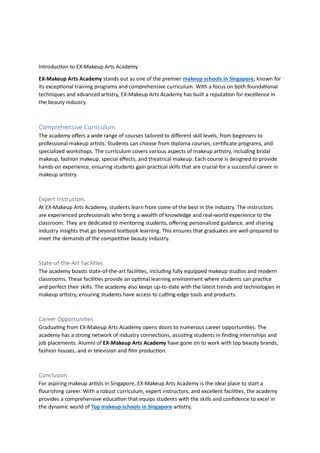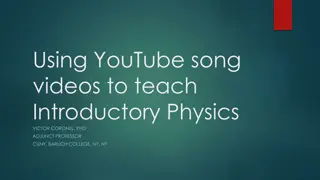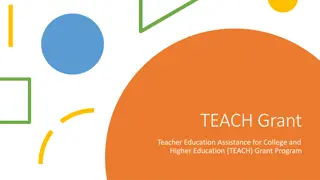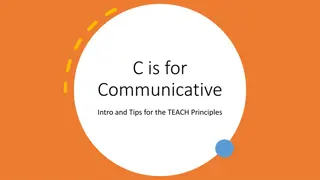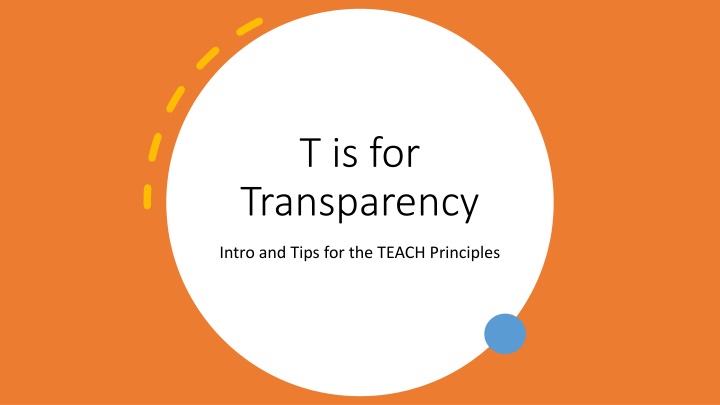
Enhancing Teaching Practices: Strategies for Transparency & Student Engagement
This content introduces the concept of transparent teaching principles and provides practical tips for implementing them in the classroom. It outlines the TEACH principles - Transparent, Evidence-based, Aspirational, Communicative, and Humane - emphasizing the importance of making the learning process visible and clear for all students. The examples and characteristics of transparent teaching discussed aim to help educators create a supportive and inclusive learning environment where students can thrive academically.
Download Presentation

Please find below an Image/Link to download the presentation.
The content on the website is provided AS IS for your information and personal use only. It may not be sold, licensed, or shared on other websites without obtaining consent from the author. If you encounter any issues during the download, it is possible that the publisher has removed the file from their server.
You are allowed to download the files provided on this website for personal or commercial use, subject to the condition that they are used lawfully. All files are the property of their respective owners.
The content on the website is provided AS IS for your information and personal use only. It may not be sold, licensed, or shared on other websites without obtaining consent from the author.
E N D
Presentation Transcript
T is for Transparency Intro and Tips for the TEACH Principles
Developed by the Senate Teaching and Learning Committee Academic Senate endorsed spring 2022 "Principles of Good Practice in Teaching" Based in: Need for a better "definition" of good teaching Literature around best practices What are the What are the TEACH TEACH Principles? Principles?
TEACH TRANSPARENT EVIDENCE-BASED ASPIRATIONAL COMMUNICATIVE HUMANE ysu.edu/TEACH
Transparent Teaching Transparent Teaching Example: Write a 5-page paper taking a position on the last reading s central controversy About making the invisible, visible Take notes on the reading Relate the reading to lecture and class discussion Consider the reading in relation to previous course material Use standard written English Be knowledgeable about instructor s style guide preference Know which points the instructor wants you to focus on The paper will be graded on your ability to explore the topic, not repeat back what the reading says Exposing the hidden curriculum and hidden structures of college for ALL students
Transparent Teaching Transparent Teaching About making the invisible, visible What are some other examples of the hidden curriculum for students? Exposing the hidden curriculum and hidden structures of college for ALL students
Transparent Teaching Characteristics Transparent Teaching Characteristics Provides and follows the course syllabus Clearly defines grading and attendance policies Posts syllabus and grades Offers a clear and organized course structure (calendar, consistent expectations) Sets expectations for returning student work Connects course activities and learning goals Explains what success looks like (e.g., gives examples, rubrics)
Transparent Tip: Transparent Tip: Single Single- -Point Rubrics Point Rubrics Easy way to communicate expectations and how you will weigh them (e.g., how important are ideas vs grammar) Using your prompt to develop a rubric can ensure your instructions are clear Less onerous than an analytical rubric Speeds up grading only commenting on above/below expectations From cultofpedagogy.com
Single Single- -Point Rubric Examples Point Rubric Examples From Carnegie Mellon s Eberly Center From Alison Kaufman
Single Single- - Point Point Rubric Rubric Examples Examples From ITL
Single Single- -Point Rubric Examples Rubric Examples Point From Lori Cohen @lcctchr
Particularly with bigger papers/projects/assignments Provides a source of formative feedback Provide 2-4 examples (more than one to avoid copies) Consider including: stronger, weaker, mixed, highlight specific features Attend to consent for examples Bonus Transparent Tip: Use Exemplars
DID YOU SIGN-IN? Engage with ITL 3 times this fall through workshops, book club, podcast groups, or consults and receive a $25 gift card. THANK YOU for joining us today! Before you go Complete a feedback card or fill out a feedback form online.

![❤[PDF]⚡ Escaping from Eden: Does Genesis Teach that the Human Race was Created](/thumb/21697/pdf-escaping-from-eden-does-genesis-teach-that-the-human-race-was-created.jpg)
